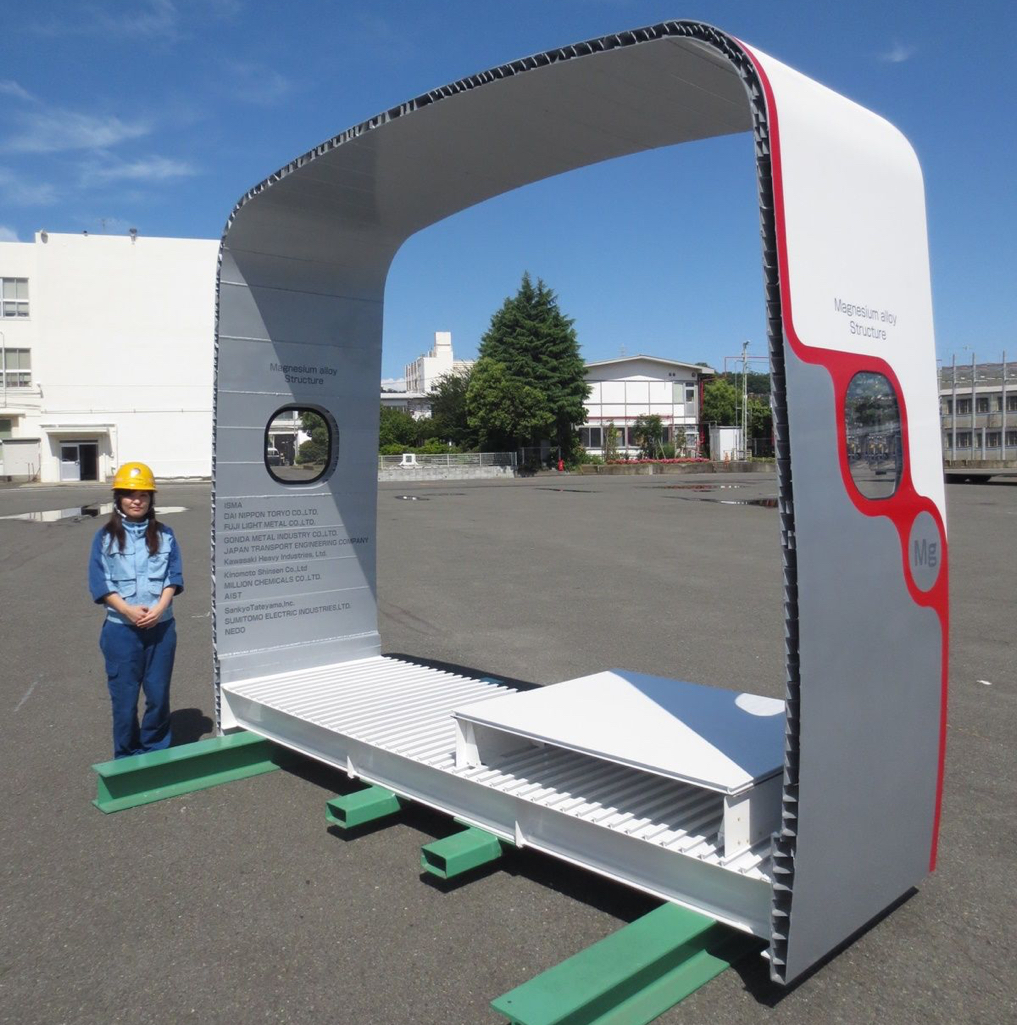
The New Energy and Industrial Technology Development Organization (NEDO), a Japanese governmental research and development agency, and the Innovative Structural Materials Association (ISMA) jointly developed a partial prototype structure for a high speed railway vehicle of the same cross section size as the Shinkansen bullet train, using a new magnesium alloy. According to the organizations, the structure is the world’s largest large-scale structure (2.9 m high × 3.2 m wide × 1.0 m long) using a flame-retardant magnesium alloy and is a major step toward practical application of the alloy in a high-speed railway car body structure.
Due to the increasing demand for higher speed and more energy savings for railroads, there is an increasing need to reduce the weight of the railway vehicle structures. The magnesium alloy used in the trial production structure was developed by the organizations to improve flame retardancy, strength, and workability. By using a magnesium alloy 30% lighter than aluminum, the weight of the vehicle structure was drastically reduced.
Currently, 38 firms — including material manufacturers, processing companies, automakers, railway car manufacturers, two government research organizations, and one university — are members of ISMA.
Prototype Development
Four technologies were developed in order to make trial production of the body structure possible, including the fire-retardant magnesium alloy and extrusion processing, processing and joining technologies, anti-corrosion properties, and technology for trial production of large structures.
Magnesium Alloy: In addition to improving the flame retardancy of the alloy, assuring the strength and ductility equivalent to that of currently used aluminum alloys was important to the project. In general, the addition of calcium is effective for securing the flame retardancy of magnesium. However, as calcium is added, coarse crystallized substances are formed and the extrusion speed decreases. The organizations developed two types of alloys. The team was able to manufacture double-skin extruded materials by optimizing the chemical composition and microstructure of the pre-extruded magnesium billet — creating a substitution for A6N01 aluminum alloy.
For high strength alloys, in order to produce single-skin extruded materials and rolled plate materials, they optimized chemical components, process conditions, heat treatment conditions, and other parameters in order to produce a magnesium material with the same strength and ductility as the A7N01 aluminum alloy.
Processing and Joining Technologies: Establishing advanced processing and joining technologies was indispensable for ensuring the reliability of joints within the vehicle structure. Seisakusho Co., Ltd. provided studies on various bonding methods such as friction stir welding (FSW), MIG welding, and TIG welding. A series of tests were carried out on the joining techniques for the new alloy and determination of the optimal joining condition range was based on joining strength. The composition of the filler metal for the MIG welding was produced in cooperation with Kinomoto Shinzo Co., Ltd.
Corrosion Protection: Since magnesium is chemically unstable and easy to corrode, establishing corrosion protection technology is a particularly important development for transportation applications. Undertaken by Dainippon Ink & Co., Ltd. and Million Chemical Co., Ltd., the team developed a pretreatment and room temperature curing paint for use on the large magnesium structure that was applied it to prototype parts.
Trial Production of the Structure: Together with the rolling stock manufacturers, General Vehicle Manufacturing Co., Ltd. and Kawasaki Heavy Industries, Ltd., the team combined the alloy, processing, joining, and corrosion technology developments in order to produce the prototype part panel. They succeeded in prototyping the all-magnesium alloy high-speed railway vehicle subassembly, confirming that the weight can be reduced by 25% or more while providing the same rigidity condition as conventional aluminum alloy member.
Future Development
Based on the results of this prototype structure, the organizations are planning to proceed with the prototyping of a longer vehicle structure. This will include the production of a 5 m long structure, simulating the current Shinkansen bullet train structure, which will be used to carry out fatigue tests under operational conditions to ensure reliability. These results will help to determine the structure’s safety during long-term use. Ultimately, the team aims to commercialize the high-speed railway structure made of flame-retardant magnesium alloy, contributing to the lighter weight, higher speed, and energy savings of railway vehicles.
